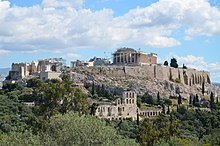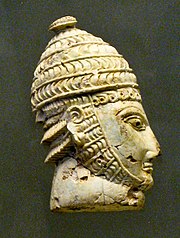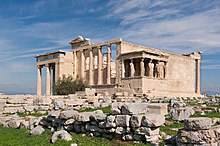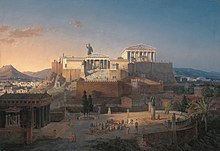Acropolis of Athens
| UNESCO World Heritage Site | |
|---|---|

The Acropolis of Athens, seen from the Hill of the Muses
| |
| Location | Athens, Attica, Greece |
| Criteria | Cultural: i, ii, iii, iv, vi |
| Reference | 404 |
| Inscription | 1987 (11th Session) |
| Area | 3.04 ha |
| Buffer zone | 116.71 ha |
| Coordinates | 37°58′15″N 23°43′34″ECoordinates: 37°58′15″N 23°43′34″E |
The Acropolis of Athens is an ancient citadel located on a rocky outcrop above the city of Athens and contains the remains of several ancient buildings of great architectural and historic significance, the most famous being the Parthenon. The word acropolis is from the Greek words ἄκρον (akron, "highest point, extremity") and πόλις (polis, "city").[1] Although the term acropolis is generic and there are many other acropoleis in Greece, the significance of the Acropolis of Athens is such that it is commonly known as "The Acropolis" without qualification. During ancient times it was known also more properly as Cecropia, after the legendary serpent-man, Cecrops, the supposed first Athenian king.
While there is evidence that the hill was inhabited as far back as the fourth millennium BC, it was Pericles (c. 495–429 BC) in the fifth century BC who coordinated the construction of the site's most important present remains including the Parthenon, the Propylaia, the Erechtheion and the Temple of Athena Nike.[2][3] The Parthenon and the other buildings were seriously damaged during the 1687 siege by the Venetians during the Morean War when gunpowder being stored in the Parthenon was hit by a cannonball and exploded.[4]
Contents
History[edit]
Early settlement[edit]
The Acropolis is located on a flattish-topped rock that rises 150 m (490 ft) above sea level in the city of Athens, with a surface area of about 3 hectares (7.4 acres). While the earliest artifacts date to the Middle Neolithic era, there have been documented habitations in Attica from the Early Neolithic period (6th millennium BC).
There is little doubt that a Mycenaean megaron palace stood upon the hill during the late Bronze Age. Nothing of this megaron survives except, probably, a single limestone column-base and pieces of several sandstone steps.[5] Soon after the palace was constructed, a Cyclopean massive circuit wall was built, 760 meters long, up to 10 meters high, and ranging from 3.5 to 6 meters thick. This wall would serve as the main defense for the acropolis until the 5th century.[6] The wall consisted of two parapets built with large stone blocks and cemented with an earth mortar called emplekton (Greek: ἔμπλεκτον).[7] The wall uses typical Mycenaean conventions in that it followed the natural contour of the terrain and its gate, which was towards the south, was arranged obliquely, with a parapet and tower overhanging the incomers' right-hand side, thus facilitating defense. There were two lesser approaches up the hill on its north side, consisting of steep, narrow flights of steps cut in the rock. Homer is assumed to refer to this fortification when he mentions the "strong-built House of Erechtheus" (Odyssey 7.81). At some time before the 13th century BC, an earthquake caused a fissure near the northeastern edge of the Acropolis. This fissure extended some 35 meters to a bed of soft marl in which a well was dug.[8] An elaborate set of stairs was built and the well served as an invaluable, protected source of drinking water during times of siege for some portion of the Mycenaean period.[9]
Archaic Acropolis[edit]
Not much is known about the architectural appearance of the Acropolis until the Archaic era. During the 7th and the 6th centuries BC, the site was controlled by Kylon during the failed Kylonian revolt,[10] and twice by Peisistratos; each of these were attempts directed at seizing political power by coups d'état. Apart from the Hekatompedon mentioned later, Peisistratos also built an entry gate or Propylaea.[11] Nevertheless, it seems that a nine-gate wall, the Enneapylon,[12] had been built around the biggest water spring, the Clepsydra, at the northwestern foot.
A temple to Athena Polias, the tutelary deity of the city, was erected between 570–550 BC. This Doric limestone building, from which many relics survive, is referred to as the Hekatompedon (Greek for "hundred–footed"), Ur-Parthenon (German for "original Parthenon" or "primitive Parthenon"), H–Architecture or Bluebeard temple, after the pedimental three-bodied man-serpent sculpture, whose beards were painted dark blue. Whether this temple replaced an older one, or just a sacred precinct or altar, is not known. Probably, the Hekatompedon was built where the Parthenon now stands.[13]
Between 529–520 BC yet another temple was built by the Peisistratids, the Old Temple of Athena, usually referred to as the Arkhaios Neōs (ἀρχαῖος νεώς, "ancient temple"). This temple of Athena Polias was built upon the Dörpfeld foundations,[14] between the Erechtheion and the still-standing Parthenon. Arkhaios Neōs was destroyed as part of the Achaemenid destruction of Athens during the Second Persian invasion of Greece during 480–479 BC; however, the temple was probably reconstructed during 454 BC, since the treasury of the Delian League was transferred in its opisthodomos. The temple may have been burnt down during 406/405 BC as Xenophon mentions that the old temple of Athena was set afire. Pausanias does not mention it in his 2nd century AD Description of Greece.[15]
Around 500 BC the Hekatompedon was dismantled to make place for a new grander building, the "Older Parthenon" (often referred to as the Pre-Parthenon, "early Parthenon"). For this reason, Athenians decided to stop the construction of the Olympieion temple which was connoted with the tyrant Peisistratos and his sons and, instead, used the Piraeus limestone destined for the Olympieion to build the Older Parthenon. In order to accommodate the new temple, the south part of the summit was cleared, made level by adding some 8,000 two-ton blocks of limestone, a foundation 11 m (36 ft) deep at some points, and the rest was filled with soil kept in place by the retaining wall. However, after the victorious Battle of Marathon in 490 BC, the plan was revised and marble was used instead. The limestone phase of the building is referred to as Pre-Parthenon I and the marble phase as Pre-Parthenon II. In 485 BC, construction stalled to save resources as Xerxes became king of Persia and war seemed imminent.[16] The Older Parthenon was still under construction when the Persians invaded and sacked the city in 480 BC. The building was burned and looted, along with the Ancient Temple and practically everything else on the rock.[17][18] After the Persian crisis had subsided, the Athenians incorporated many architectural parts of the unfinished temple (unfluted column drums, triglyphs, metopes, etc.) into the newly built northern curtain wall of the Acropolis, where they served as a prominent "war memorial" and can still be seen today. The devastated site was cleared of debris. Statuary, cult objects, religious offerings and unsalvageable architectural members were buried ceremoniously in several deeply dug pits on the hill, serving conveniently as a fill for the artificial plateau created around the classic Parthenon. This "Persian debris" is the richest archaeological deposit excavated on the Acropolis by 1890.[19]
The Periclean building program[edit]
After winning at Eurymedon during 468 BC, Cimon and Themistocles ordered the reconstruction of the southern and northern walls of the Acropolis. Most of the major temples, including the Parthenon, were rebuilt by order of Pericles during the so-called Golden Age of Athens (460–430 BC). Phidias, an Athenian sculptor, and Ictinus and Callicrates, two famous architects, were responsible for the reconstruction.[20]
During 437 BC, Mnesicles started building the Propylaea, a monumental gate at the western end of the Acropolis with Doric columns of Pentelic marble, built partly upon the old propylaea of Peisistratos.[21] These colonnades were almost finished during 432 BC and had two wings, the northern one decorated with paintings by Polygnotus.[22] About the same time, south of the Propylaea, building started on the small Ionic Temple of Athena Nike in Pentelic marble with tetrastyle porches, preserving the essentials of Greek temple design. After an interruption caused by the Peloponnesian War, the temple was finished during the time of Nicias' peace, between 421 BC and 409 BC.[23]
Construction of the elegant temple of Erechtheion in Pentelic marble (421–406 BC) was in accordance with a complex plan which took account of the extremely uneven ground and the need to circumvent several shrines in the area. The entrance, facing east, is lined with six Ionic columns. Unusually, the temple has two porches, one on the northwest corner borne by Ionic columns, the other, to the southwest, supported by huge female figures or Caryatids. The eastern part of the temple was dedicated to Athena Polias, while the western part, serving the cult of the archaic king Poseidon-Erechtheus, housed the altars of Hephaestus and Voutos, brother of Erechtheus. Little is known about the original plan of the interior which was destroyed by fire during the first century BC and has been rebuilt several times.[24][25]
During the same period, a combination of sacred precincts including the temples of Athena Polias, Poseidon, Erechtheus, Cecrops, Herse, Pandrosos and Aglauros, with its Kore Porch (Porch of the Maidens) or Caryatids' balcony was begun.[26] Between the temple of Athena Nike and the Parthenon, there was the Sanctuary of Artemis Brauronia (or the Brauroneion), the goddess represented as a bear and worshipped in the deme of Brauron. According to Pausanias, a wooden statue or xoanon of the goddess and a statue of Artemis made by Praxiteles during the 4th century BC were both in the sanctuary.[27]
Behind the Propylaea, Phidias' gigantic bronze statue of Athena Promachos ("Athena who fights in the front line"), built between 450 BC and 448 BC, dominated. The base was 1.50 m (4 ft 11 in) high, while the total height of the statue was 9 m (30 ft). The goddess held a lance the gilt tip of which could be seen as a reflection by crews on ships rounding Cape Sounion, and a giant shield on the left side, decorated by Mys with images of the fight between the Centaurs and the Lapiths.[28] Other monuments that have left almost nothing visible to the present day are the Chalkotheke, the Pandroseion, Pandion's sanctuary, Athena's altar, Zeus Polieus's sanctuary and, from Roman times, the circular temple of Augustus and Rome.[29]
Hellenistic and Roman period[edit]
During the Hellenistic and Roman periods, many of the existing buildings in the area of the Acropolis were repaired, due to damage from age, and occasionally, war.[30] Monuments to foreign kings were erected, notably those of the Attalid kings of Pergamon Attalos II (in front of the NW corner of the Parthenon), and Eumenes II, in front of the Propylaia. These were rededicated during the early Roman Empire to Augustus or Claudius (uncertain), and Agrippa, respectively.[31] Eumenes was also responsible for constructing a stoa on the South slope, not unlike that of Attalos in the Agora below.[32]
During the Julio-Claudian period, the Temple of Rome and Augustus, a small, round edifice, about 23 meters from the Parthenon, was to be the last significant ancient construction on the summit of the rock.[33] Around the same time, on the North slope, in a cave next to the one dedicated to Pan since the classical period, a sanctuary was founded where the archons dedicated to Apollo on assuming office.[34] During 161 AD, on the South slope, the Roman Herodes Atticus built his grand amphitheatre or Odeon. It was destroyed by the invading Herulians a century later but was reconstructed during the 1950s.[35]
During the 3rd century, under threat from a Herulian invasion, repairs were made to the Acropolis walls, and the "Beulé Gate" was constructed to restrict entrance in front of the Propylaia, thus returning the Acropolis to use as a fortress.[30]
Byzantine, Latin and Ottoman period[edit]
During the Byzantine period, the Parthenon was used as a church, dedicated to the Virgin Mary.[36] During the Latin Duchy of Athens, the Acropolis functioned as the city's administrative center, with the Parthenon as its cathedral, and the Propylaia as part of the Ducal Palace.[37] A large tower was added, the "Frankopyrgos", demolished during the 19th century.[38]
After the Ottoman conquest of Greece, the Parthenon was used as the garrison headquarters of the Turkish army,[39] and the Erechtheum was turned into the Governor's private Harem. The buildings of the Acropolis suffered significant damage during the 1687 siege by the Venetians in the Morean War. The Parthenon, which was being used as a gunpowder magazine, was hit by artillery shot and damaged severely.[40]
During subsequent years, the Acropolis was a site of bustling human activity with many Byzantine, Frankish, and Ottoman structures. The dominant feature during the Ottoman period was a mosque inside the Parthenon, complete with a minaret.
The Acropolis was besieged thrice during the Greek War of Independence (two sieges from the Greeks in 1821–1822 and one from the Ottomans in 1826–1827. A new bulwark named after Odysseas Androutsos was built by the Greeks between 1822 and 1825 to protect the recently rediscovered Klepsydra spring which became the sole fresh water supply of the fortress.
After the independence, most features that dated from the Byzantine, Frankish and Ottoman periods were cleared from the site in an attempt to restore the monument to its original form, "cleansed" of all later additions.[41]
Archaeological remains[edit]
The entrance to the Acropolis was a monumental gateway termed the Propylaea. To the south of the entrance is the tiny Temple of Athena Nike. At the centre of the Acropolis is the Parthenon or Temple of Athena Parthenos (Athena the Virgin). East of the entrance and north of the Parthenon is the temple known as the Erechtheum. South of the platform that forms the top of the Acropolis there are also the remains of the ancient, though often remodelled, Theatre of Dionysus. A few hundred metres away, there is the now partially reconstructed Odeon of Herodes Atticus.[42]
All the valuable ancient artifacts are situated in the Acropolis Museum, which resides on the southern slope of the same rock, 280 metres from the Parthenon.[43]
Site plan[edit]
Site plan of the Acropolis at Athens showing the major archaeological re













No comments:
Post a Comment